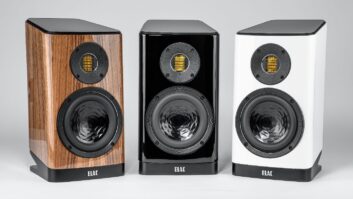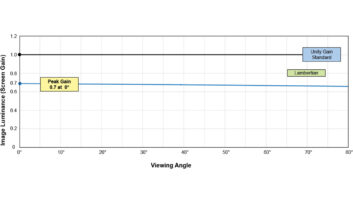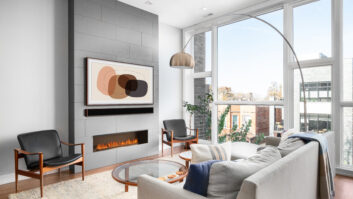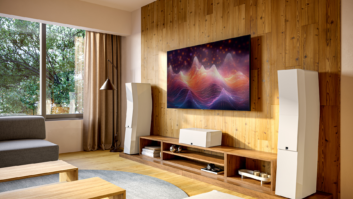You finished installing the latest multichannel audio system, you have configured it all and have even checked that all the signals are going where your plans say they are supposed to go and that when they get there, they have survived the long, winding wiring road through hookups, connectors and interfaces. After some time spent debugging one of those pesky hum loops, you are finally ready to move on to some acoustic verifications and calibrations.
Go get those Q Tips, clean out your ears and get ready to do some listening, because your ears are going to do a lot of the work here.
Room Verification
Acoustic Treatment Layout. At the beginning of this whole project you should have done or contracted someone to do an acoustical design for the room. Like I mentioned once before; a top-of-the line system placed in an acoustically challenged room will sound so-so at best. It won’t matter how much time you put into setting levels, moving speakers, swapping cables or trying different models of power conditioners; if the equipment-room interface is flawed from the start, you will end up with mid-line sound at best. So let’s say that you did have an acoustical plan for the room. You had better now check that all of the treatments were placed in the right locations, at the right heights and with the right orientations. The two common treatment materials are absorbers and diffusers. The orientation of some diffuser materials does matter, and they had better match what’s on the plan, or else diffused sound energy might be redirected to the wrong areas of the room.
* Slap Echo Check. One the purposes of the acoustic treatment materials is to eliminate multiple sound reflections between parallel surfaces in the room (a long-winded way to say echoes). Verify that the layout plan and implementation are appropriate by listening for these echoes. Use your hands for this one. Simply clap your hands and listen for a fluttering echo set up between wall pairs. Walk around the room and check this over and over again at different heights. Ideally, there should not be any echoes anywhere. One could argue that slap echoes that happen far away from the listening area might not be audible, but I have found these to be detectable by careful listeners in real program material, so make sure the room never talks back at you.
* Boundary Reflections. Another purpose of acoustic treatments is to get rid of strong sound reflections from hard surfaces in the room. These reflections really mess up your sound quality and tend to flatten the soundstage.
At least, check for each of the front speakers in turn. Play pink noise through them and move your head from left to right two or three feet at several seats in the listening area. Also bop your head up and down from seated height and listen. In either motion you should not detect an audibly “phasey”, “swishy” sound character to the pink noise. Note that bare floors, hard and flat coffee tables, bare walls and windows are all murderous for this test. They should be treated with some form of absorption or diffusion or you just won’t get the system to sing (for more about this test, see the June 2001 issue of RS).
* Background Noise. One important element of good sound is dynamic range. On the top end amplifier power, speaker sensitivity and power handling determine it. On the bottom end, hiss from the electronics and the room’s background noise will set the limit point. For decent sonics you should get at least 100 dB out of the whole enchilada. That’s 120 dB SPL peaks (that’s loud) and noise below 20 dB SPL in the midrange (that’s actually not that quiet…).
An acoustical noise floor can be measured out in a few ways these days, but the most common is the NC (Noise Criteria) rating (see Figure 1). It weighs the noise according to the human auditory sensitivity at different frequencies and levels. A good home theater should have background noise below NC20; anything higher and you are obliterating low-level detail, and the entire sense of dynamics will be smashed to pieces. A simple way to verify the NC value is to use a spectrum analyzer equipped for this feature, such as the Gold Line DSP30 with the NC option and the MK10 microphone. If you don’t have this handy gizmo, then use your ears. Put in a set of earplugs and let your auditory system sit with it for a minute. Then pull out the plugs and listen for the noise level. You will hear all the projector fans, HVAC flow and compressors, traffic noise and more that you didn’t even know were there. So go get rid of it! Look for noise sources one by one. Turn them off, and if they audibly affect the overall noise floor, establish a plan to eliminate them permanently. Front Speaker Placement
I am not going to make this an in-depth dissertation on proper speaker placement, and besides the acoustical layout plan should have determined this. Nonetheless, here are a few simple guidelines. Proper front speaker placement is a solution to a multiple equation set:
a) They should be at or slightly above seated ear height.
b) Their interface with the room standing wave character should minimize response errors.
c) Their low frequency boundary reflections should result in the
smoothest response possible (see Figure 2). Keep them away from corners, floors and ceilings. Also, try to put the three front speakers in a similar acoustical environment so that they behave with sonic similarity.
d) The height should match the screen height
e) The height should allow for proper listening sightlines for all rows of listeners
f) Center height should be within two feet from that of the left/right, and preferably identical.
g) The left/right speakers should form a 45-degree triangle to the listener location.
h) The center speaker should not be placed horizontally unless it was properly designed to do so (see the discussion on radiation pattern coverage later in the article).
i) Avoid placing the speakers in cabinetry wherever possible (see the discussion on this below).
So how do you make this all work? It’s really quite difficult and pretty darn near impossible if you don’t use an acoustically transparent screen, and the Stewart Microperf is the only one I know to be good enough to not mess up the sound.
I recommend starting with an open area for the speakers, which can be covered by an acoustically transparent fabric false wall. Put the Stewart Microperf screen in it, locate the speakers by using one of the modeling programs such as CARA, RPG Room Optimizer or even CAAT, applying the constraints outlined in “a” through “i” above, and hope for the best through the process.
Be prepared to fine-tune the actual location during calibration, using a spectrum analyzer, your ears and some good intuition. I do think that doing the placement from scratch during the tweaking time without a planned guideline is a great way to burn up your client’s patience, the budget and your sanity. It may have been okay back in the 2-channel days, but now that we have up to 8 channels worth of speakers to place, you cannot hope to get there without some math modeling, test equipment and a whole lot of experience.
* Front Speakers in Cabinets. Unfortunately, we all have to do this once in awhile, but always remember that the sound of the front speakers placed in cabinets will be thoroughly altered by the added enclosure formed by the cabinetry. Luckily, there are a few solutions. Start by making the cabinet “breathe” by drilling large holes in the side, bottom and top boundaries around the speakers. Also it’s good to cut out the rear panel section behind the speakers. Absorb the cavity resonances with dense fiberglass, polyfill, or foam placed all around the speakers. Build a baffle around the front face of the speakers to prevent bass sounds from wrapping into the cavity formed by the shelf unit (some rear-ported speakers might not “like” this solution). Be prepared to equalize the speakers, because even with all of the above solutions you will end up with a frequency response that is less than ideal. Also, remember to treat the grille frame area with some absorptive material to reduce internal reflections and diffractions.
* Front Speaker Aiming. Before doing any listening tests on the speakers you will need to aim them toward the listening area. Yes, most speakers have a finite radiation pattern and should be adjusted accordingly. This is a simple listening test using pink noise as the source material. Listen to the pink noise character, and, if you want, measure it with a real time analyzer (RTA). Aim the vertical axis of each speaker for best response at ear height(s). Then aim the horizontal axis for best left-to-right coverage across seats; that usually means pointing the speaker directly towards the middle seat.
* Front Speaker Placement Listening Tests. Now that you have placed the front speakers according to all the guidelines above, it is time to listen to the results and adjust further. First listen to the phantom image created between the left and right speakers. Make sure to sit equidistant to the left and right speakers. Select 2-channel program material that has strong central information or even listen to a test tone, like the pulsed narrowband pink noise on Chapter 20 of the Gold Line 5.1 Toolkit DVD. The central image should be sharp and clear, almost as if it came from the center speaker. If you are not sure of the image clarity, you can invert the polarity of one of the speakers to listen for the “hole-in-the middle” effect. If in either case the image is just too unclear, try moving the left-right speakers closer to you, or closer to each other. Maybe even try moving your seat a little, or listen at different heights. Maybe you’ll find a better location in the room.
If you have a spectrum analyzer you should measure the electro-acoustic frequency response of each speaker and try different locations around a 2-foot circle to see if you can flatten out the bumps and dips in the response curve. This is called placement equalization and should be performed on any system where placement flexibility is possible. By moving the speakers around you can reduce the overlap regions in boundary reflections as well as reduce room standing wave interface errors. Ultimately your ears and your measurement equipment, coupled with intelligent modeling of the room acoustic and placement conditions, will guide you toward the best front speaker locations.
Once you have placed the left/right speakers it is time to work on the center speakers. The same procedures go to work here too. For phantom imaging, listen to the test tones in Chapters 21 and 22 of the 5.1 Toolkit DVD. These sounds are destined to play back at mid points between the left and center, then center and right speaker locations. Again, the phantom images should be clear and will depend on proper speaker placement. Try moving the center speaker around a bit to verify the best imaging and measure for the smoothest frequency response.
Remember to reset the time synchronization delays in the processor if you have repositioned the speakers, or else the imaging will be completely messed up.
* Perforated Screen Verification. As I mentioned earlier, a micro-perforated screen is pretty much the only way to make the front speaker placement process work correctly in a good home theater with two-piece projection. For this solution to be effective you need to follow some rules. The screen needs to be reasonably transparent, acoustically. You can measure this by using a spectrum analyzer and look for no more than 3 dB attenuation at 10 kHz, with gradually increasing loss at higher frequencies. Or you can use the THX-certified Stewart MicroPerf series screens. Do make sure to leave 6 inches of room between the speaker and the screen to avoid high-frequency reflection effects. Also, I recommend making the entire area behind the screen black and sound absorbent to avoid light and sound reflections.
* Verify Speaker Coverage. All the placement work you did until now was probably listened to and measured at the main seating position. So what about the other sets in the “house?” I recommend checking for coverage uniformity by doing a quick listening test. Play pink noise in each of the front speakers and move through the seating area at constant ear height. As you move through the seats, the character of the pink noise sound should remain unchanged. If the sound changes at the extremes of the seating area try pointing the speakers more in or out to compensate. Be particularly careful with traditional center speakers that have two woofers straddling a tweeter. These tend to cause nasty lobing patterns in the midrange frequencies, and result in rapid changes of sound in the room.
Subwoofer Placement
It’s time to move on to the “big bottom” guys. Just like for the front speakers, you should have a plan in place for proper subwoofer locations based on acoustical theory, aesthetics and some good intuitive knowledge accrued through your years of doing this gig. All the same modeling tools that worked for the fronts will work here, so go ahead and use them.
Remember that the subs are a lot harder to move around and hide in the room than the typically smaller front speakers in sub-sat systems. You might as well have a good plan ahead of time to prevent the “aesthetic police” from busting you for DUI (Dealing with Unplanned Installations). Here a few guidelines to follow for better subwoofer placement:
1) Keep the subs in the “front region.” There can be audible distortion and cabinet vibration sounds on the less-than-ideal subwoofer products. These cause localization cues for the products and would allow almost any listener to notice where the big box is hidden. Keep the subs near the front speakers to avoid problems with unknown products. If you have tested the subwoofers for full headroom without side effects, you can be more liberal with placement.
2) Use multiple subs in mono. This business of stereo subwoofers creates more problems than it really solves. The dominant issue with subwoofers in rooms is their interactions with the standing wave patterns in the room, and that causes errors in excess of 20 dB in frequency response. Using multiple subwoofers in mono can reduce the errors to below 10 dB and that’s very worthwhile. This is clearly a case where I will take good mono bass over questionable stereo in a frequency range where it is doubtful that the human ear can notice spatial cues anyway.
3) Measure frequency response. Hey, you might as well actually see how skewed the bass will be from those darned standing waves. The only way to know is to use an analysis system with resolution tighter than 1/12th octave below 100 Hz. You will see a series of peaks and dips and you can work on moving the subwoofer(s) around the room until some combination of locations gives you reasonable smooth bass as measured at the main seats.
4) Listen to single-tone sweep. I like to use a single tone sweep in addition to a spectrum analyzer to confirm the measured findings with an actual listening evaluation. Listen for the level peaks and holes, and even try moving around the seats with any one-problem frequency dialed up on the single tone generator. Gold Line makes the TS3, a handy low-cost battery-powered generator that you can use for this test.
5) Eliminate a room mode. As much as possible, try to place the subwoofer(s) so that it actively cancels a standing wave (see Figures 3 and 4). By placing it right on the null of one of the harmonics, or with a pair to either side of the null, you will effectively contradict the standing wave and therefore reduce the response errors in the room
Subwoofer Placement Tricks
With the guidelines in mind, here’s a recommended process to get good tight bottom end from the subwoofers. First, place the sub in the corner to determine the most active room mode patterns, then move the big boy on a plant dolly while checking the response changes on your analyzer and listening to the pink noise signal. The dolly helps in two ways: It gives you a smooth continuous motion and will save your back from certain injury.
You might find a few locations in which the bass is smoother, but not yet ideally flat within about a 6-dB error range. Try moving the seat locations a bit. You might find a combination that brings the bass response to within a respectable +/- 4-dB error range. Remember that ultimately you will need to add some electronic equalization to smooth out the remaining errors, but don’t go there until you have worked with placement and seat location adjustments. Also, once you have reset those locations you will need to redo the time synchronization delay settings in the surround processor.
For a higher level of quality you can use bass absorbers designed to treat the specific standing wave frequencies that affect your bass response. RPG makes the Modex units that work well for this, or you can try to make your own diaphragm absorbers just for fun. Look for equations in some of the recording studio acoustics books, and arm yourself with some patience and a lot of luck…
* Subwoofer Headroom Verification. Once you have found a reasonable placement solution for the subwoofer system, you should verify just how loud the thing plays. Use a 20 Hz to 80 Hz pink noise source, turn up the volume until distress, and measure the results with an SPL meter in Slow, Flat or C mode. Look for more than 105 dB for mid-line systems and more than 110 dB for high-end systems. You might be surprised by how few systems can actually make it up there. The above figures are essential for adequate film and music playback and should not be skimped on. I recommend using Title 1, Chapter 79 of the Gold Line 5.1 Audio Toolkit DVD, or for even more entertainment, Title 7 of the same DVD, affectionately nicknamed “A Whole Lotta Bass.” The first one to show me an in-room reading above 110 dB gets a free ice cream cone!
Surround Speaker Placement
Here again, just like for the front and subwoofer speakers, you should have done some amount of planning during the design phases of the project. I would feel comfortable saying that you can tolerate somewhat more errors in the low-frequency response of surround speakers than for the other channels. Most of the dominant low-end energy in movies and music is put up front, and imaging effects don’t rely on low-end accuracy as much as mid-frequency correlation. So placements that don’t optimize boundary conditions or standing wave interfaces won’t shoot down your system’s quality. That being said, ignore this disclaimer for really high-end installations. Every speaker should be optimized for best low- to mid-frequency response in the room.
Generally speaking, surround speakers should be to the sides or slightly back from the main seating area. They should be two feet above seated ear height. Don’t aim surround speakers directly to the listener’s ears or else you’ll force them to look up and notice that there’s a box on the wall rather than believe that a velociraptor is about to munch them alive… Talk about wrecking the movie! * Dipole Speaker Placement. Here are some specific rules for placement of dipolar-type surround speakers. These were first introduced as a solution to adequate surround-field coverage by the THX folks and are now pretty widespread among manufacturers of multichannel speaker packages. They tend to enhance the reverberant field balance of the surround channel and yield a good ratio of directionality and absence of localization distractions. Dipole speakers radiate sound in a figure-eight pattern with the two main lobes of sound being out of phase with each other. In the waist of the figure eight the sound pressure is effectively canceled and this area is called the null (Figure 5).
Dipole surround speakers should be placed on the sidewalls or ceiling with the radiation null pointing towards listeners. Place them around six feet high in the room for best reflection coverage.
Figures 6-12 provide pictorial guidelines for dipole surround placements given a whole variety of placement conditions
Direct Radiating Speakers
Direct radiating speakers are none other than the garden variety of speakers most commonly found from just about every manufacturer under the sun. Much of their placement guidelines follow what has been stated so far. That is, place on the sidewalls, slightly behind listener area, high in room (about six feet), and avoid placing them too close to listeners. Typically aim the speakers towards each other across the room so as to avoid the unfortunate localization issue discussed earlier.
With a couch on the back wall put the speakers to the sides of the listeners and aim them at each other or if needed to avoid localization try pointing them up towards the ceiling. Note that their sound quality might start to lack in high-frequency energy, so you might need to compensate for this with tone control or equalization.
* Surround Back Speaker Placement for Surround EX.
Surround EX is the latest development in multichannel sound formats, and provides more spatial resolution to the surround soundfield. Rather than just represent the off-screen sounds with two channels to the sides of the listeners, Surround EX adds a third channel behind the listening area and gives the sound designer more creative flexibility.
Surround EX was jointly developed by Lucasfilm THX and Dolby Laboratories and was first introduced in Star Wars Episode 1, the Phantom Menace. Since then about 70 movies have been released with the EX feature, and whenever these end up on DVD they include the extra track. In a decent listening room, EX adds significant sonic qualities and seating flexibility, and I highly recommend specifying it in to any new design.
Placing the rear speakers for Surround EX follows mostly what we have been talking about so far with a few twists, turns and variations. The largest twist is that a pair speakers placed symmetrically behind your listening position can actually produce a sound image in front of you! As amazing as that sounds, it is a well-known psychoacoustic effect referred to as “reversal.” Of course the intended effect is not for the “surround back” sound to come from in front of you. So what do you do to avoid this trap? One solution is to use dipole speakers; another solution is to offset the speaker locations so as to break the symmetry. Yet another solution is to use a fair amount of diffusive materials on the rear and sidewalls to create a less correlated soundfield. Figures 13-15 provide some illustrations to use as guides for surround back placement.
* Surround Speaker Tweaking and Aiming.
Once the speakers are in place, listen for even coverage and spaciousness using pink noise or another relatively steady signal source. Listen for balance of directionality and spaciousness. Walk around the room’s main listening area, and look for hot spots and speaker localization cues. Try moving the speakers up, forward or backwards until the hotspots go away. With dipoles aim the null towards the seating area. With direct radiators you might need to point the speakers away from the listening area. You might also need to add some diffusion acoustical treatment to the side and back walls, and maybe even the ceiling to improve the surround field coverage.
For the surround back speakers, check again for that pesky reversal issue and solve it by displacing the surrounds, adding diffusers, or aiming them in different directions.
Remember to reset the time synchronization settings after moving the speakers.
Anthony Grimani is president of Performance Media Industries, an Acoustical Architecture firm specializing in home theater design.







